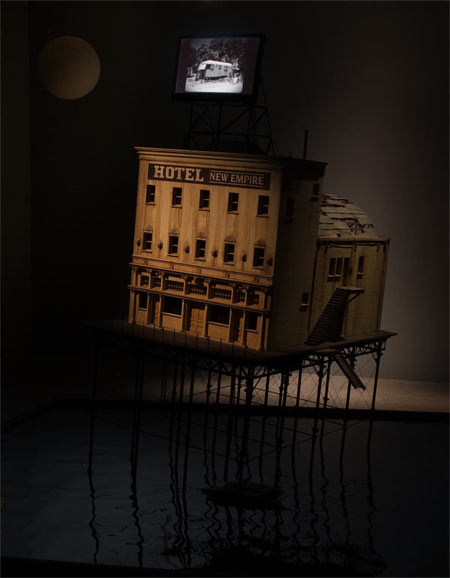
As we enter the gallery we open a pair of weathered screen doors. Above them reads a sign, “No Dancing.” The doors swing open, creaking with the lazy movement of age. As one opens and then the other, a clanging string of keys rise out of a bucket and an anchor rises out of another. The resounding echo jolts and thrusts us into a different space. We are not in “the gallery” we thought we entered. We are somewhere else. As we look around, we first see a “Cistern” (2010, cast bronze) and then, we are suddenly afloat, as two ships - a submarine, (“Neptune (Journey to the Surface)” (1985), wood and metal construction), and a weathered vessel (“Witch of Draconis,” 1983, wood and metal construction) - sail above us. We join them, sailing along, sharing their space. A flotilla of five small open boats sail silently alongside us (“Fleet,” 2010, cast bronze). We float past and look into the empty boats. A weathered copper penny lies at the bottom of one, a handful of rusty keys lie in another. Floating high above to the far right is half of a bridge span (“Bendigo,” 2009, birch and maple construction).
We reach for another age-worn door and as we push it open, we enter into a dark space in which a “Lighthouse” (2010, steel, wood) looms ahead. We have reached the shore. We are on land. Shifting our sense of proportion, we shrink to its size sensing ourselves on a boardwalk, implicitly having left the floating world behind. But have we? And “when” are we? Ladders, pipes, Greek and Victorian pillars and turrets, cargo boxes, vent pipes, clotheslines make up this “ Lighthouse.”
Magically, Michael C. McMillen’s sleight-of-hand, sets us off on a voyage elicited by objects that awaken bits and pieces of events and dreams caught in the recess of memory. Even as we look, these objects are telling us a story, daring us and challenging us to contribute to it, through our glimpses of them, through our memories of these objects in other times and places.
As we grow accustomed to the space, we see a monitor and hear a voice and music and register images of the sea crashing and flowing. Beaches and shores fill the screen. We are viewing “The Quotidian Man,” a film production by “Famous Family Films, Aero Pacific Research.” Through the keyhole of a rusty door knob - it could be the knob of the door that we turned to let us in, or another just like it - we enter a “somewhere in time.” The narrative that follows leads us through a time without time. Not a timeless time, for this is not imbued with the romantic ideal of the moment of moments.
Recurring images appear in the life of this everyday man. A fading voice repeatedly expresses concern over the “critical shortage of” but as the voice fades away, the images don’t: crashing waves, rolling seas, cisterns, oil derricks, airplanes, ocean, bathers, shore. Dates: 1953; 1933; 1963; 1943; 1993, all flash before our eyes as do the repetitive images of crashing waves, rolling sun-dappled sea, cisterns, planes, derricks, ocean, divers, bathers and shore. The images shift, rupturing linear time. One moment, we recognize the past. Then we land in the now only to return to another past.
We begin to realize that we are in a process of confrontation. We listen, at first dimly, and then, through these images we begin following the narrative of a view seen from the “Lighthouse.” The rhythm of the images both lulls and jolts us.
Our vision expands and begins to feel and think about ocean, cistern, oil derrick, planes, beaches, bathers, divers. As we gaze at the monitor, we begin to understand, silently, and stealthily. We are interacting. We are ocean, cistern, oil derrick planes, beaches and bathers and divers. We are swimming and shifting with their time and tide, while sharing water and earth.
This magical “Lighthouse” opens up a cohesive vision of that relationship. Reaching it has become a journey of an altered awareness in an altered space. Exquisite objects, bits of detritus, all have mingled together and through McMillen’s imaginative sense of place, all shift into living entities, as alive as those of us who undergo the journey.
Published courtesy of ArtSceneCal ©2010
